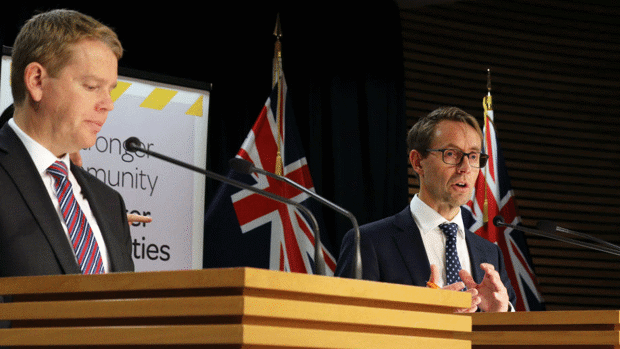Restrictions easing within Alert Level 3 for Waikato region, 74 new cases of Covid-19

- Book your Covid-19 vaccination: bookmyvaccine.covid19.health.nz
- View the latest list of locations of interest
- What to do at Alert Level 3
- What to do at Alert Level 2
- How the new Covid Protection Framework works
There are 74 Covid cases in the community today, as the Government reveals a tentative plan for schoolchildren in Years 1-10 to return to classes on November 15.
Today's cases includes 68 in Auckland and six in Waikato, all in Hamilton and all linked to previous cases.
Two close contacts of person who travelled to Blenheim from Waikato have returned negative results, two others are awaiting results.
Covid-19 Response Minister Chris Hipkins and director-general of health Dr Ashley Bloomfield are providing today's update.
Waikato alert level eases from midnight
From 11.59pm tonight restrictions will ease "a little" for Waikato.
People can meet in outdoor gatherings from two households and with social distancing. Recreational activities such as golfing will be allowed.
Early learning services can re-open with a maximum of 10 people in each bubble.
It's the same restrictions that Auckland is currently under. People will not be allowed to travel outside of Waikato.
Cabinet will review the alert level on Monday, along with the review on Auckland restrictions.
Northland remains at alert level 2, but people in the region should remain "vigilant" and monitor locations of interest and for symptoms, Hipkins said.
The South Island remains in alert level 2.
Hipkins said he is pleased to hear positive reports from those who have returned to school this week, who are preparing for NCEA exams.
November 15 tentative date for school return
Hipkins said he asked education officials to work with representatives from primary schools over the coming week, on the basis of an indicative start date of November 15 for primary schools opening, subject to "events closer to the time".
It would involve groups of students attending on different days to keep numbers smaller, and outdoor lessons, Hipkins said.
This was being considered whether early learning centres could extend numbers from 10 to 20 on November 15 also.
Hipkins said we are more likely to see cases emerging outside of Auckland.
It was not a question of if but when cases emerged outside Auckland. He said the best thing New Zealanders can do is to get vaccinated to enjoy greater freedoms over summer.
Hipkins said "stamping the virus out" remained the best course of action for places outside of Auckland until vaccination rates improved.
Bloomfield said health officials were expecting information from Pfizer in first two weeks of November about vaccines for children aged 5-11, and then advice would be given to
ministers.
Pfizer is making an application for a child version of its vaccine, and places in the US have it ready to go should it be approved for use, Bloomfield said. This will affect when the vaccine can roll out here.
Ministers are meeting this afternoon to discuss changes to the length of MIQ stays, which will be announced tomorrow, Hipkins said.
A total of 3 million Kiwis are now fully vaccinated against Covid, the Ministry of Health said in today's update.
There are four new border cases, three of which are historical.
The first case flew directly from the United States on October 21 and is isolating in Christchurch.
The three historical cases flew via Singapore and tested positive on day 6. They are also in Christchurch.
The other two also flew from the United States on October 21 and tested positive on arrival. The two are in Auckland.
There were 12,639 total vaccines issued in Auckland yesterday.
There have been no new wastewater detections.
Yesterday there were 79 community cases, including four in Waikato - all of which were expected and linked.
Six cases in Waikato remain unlinked, and two bakeries were added as locations of interest in Tokoroa. They were visited by the case who spent the night in Tokoroa before flying to Blenheim from Rotorua Airport.
Waikato is in its fourth week at level 3.
That is likely to be extended unless public health officials believe they have a ring around all of the cases, both detected and undetected.
Much of that will depend on how likely they think the unlinked cases will be resolved, and whether they believe they already know all of the close contacts.
Vaccination coverage is also a factor. The first dose coverage of eligible people living in the Waikato DHB region is 85 per cent, while the second dose coverage is 68 per cent.
Hipkins has previously cautioned about sending Year 1 to 10 students in Auckland back to school, given that most of them cannot be vaccinated because they are under 12.
That has called into question whether they will return to the classroom at all this year.
Developmental paediatrician Dr Jin Russell has outlined a number of measures that can be implemented to reduce the risk of school spread.
The greatest risk of transmission is from adult to child, rather than child to child.
This risk will be reduced with the Government's mandate for education workers to be fully vaccinated, though they have until November 15 to get a first dose, and until January 1 to get a second dose.
Russell has also stressed the importance of ventilation and filtration in classrooms, noting the use of 51,000 air filters in Victoria.
Hipkins has previously said it's not viable to install air filters in 35,000 classrooms in New Zealand because it would cost millions of dollars to do something that, in some circumstances, is better achieved with open doors and windows.
He has previously said he expected more face mask use in educational settings, at least in the short term.
Parts of Waikato have been in alert level 3 for just over three weeks, following cases filtering out of Auckland and infecting people in Hamilton, Raglan and the Te Awamutu area.

For more information visit covid19.govt.nz.
This article was first published by the NZ Herald and is republished here with permission.

